
The Condor Legion was a unit of military personnel from the air force and army of Nazi Germany’s Wehrmacht which served with the Nationalist faction during the Spanish Civil War. The Condor Legion developed methods of strategic bombing that were used widely during the Second World War. The bombing of Guernica was the most infamous operation by the Condor Legion. Hugo Sperrle commanded the unit's aircraft formations and Wilhelm Ritter von Thoma commanded the ground element.

Werner Mölders was a World War II German Luftwaffe pilot, wing commander, and the leading German fighter ace in the Spanish Civil War. He became the first pilot in aviation history to shoot down 100 enemy aircraft and was highly decorated for his achievements. Mölders developed fighter tactics that led to the finger-four formation. He died in a plane crash as a passenger.

Jagdgeschwader 52 was a German World War II fighter Geschwader (wing) that exclusively used the Messerschmitt Bf 109 throughout the war. The unit originally formed near Munich in November 1938, then moved to a base near Stuttgart. JG 52 became the most successful fighter-Geschwader of the war, with a claimed total of more than 10,000 victories over enemy aircraft during World War II. It was the unit of the top three scoring flying aces of all time, Erich Hartmann, Gerhard Barkhorn and Günther Rall.
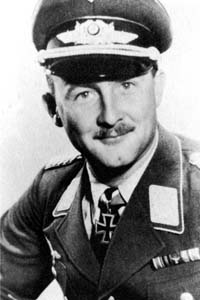
Wolfgang Schellmann was a German Luftwaffe military aviator during the Spanish Civil War and World War II. As a fighter ace, he is credited with 25 enemy aircraft shot down, including 12 in Spain, 12 on the Western Front and one on the Eastern Front of World War II.
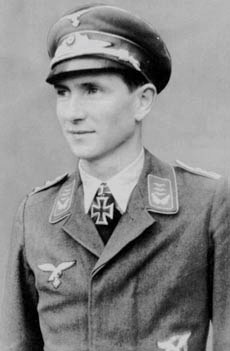
Wilhelm Balthasar was a German Luftwaffe military aviator and wing commander during World War II. As a fighter ace, he is credited with seven aerial victories during the Spanish Civil War and further 40 aerial victories on the Western Front of World War II. He flew about 300 combat missions during World War II in addition to 465 in Spain.

Otto Hans "Hannes" Trautloft was a German Luftwaffe military aviator during the Spanish Civil War and World War II, and general in the postwar German Air Force. As a fighter ace, he is credited with 58 enemy aircraft shot down, including 5 in Spain, 8 on the Western Front and 45 on the Eastern Front of World War II.
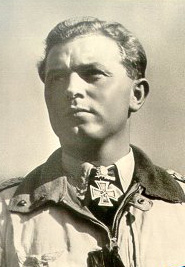
Walter "Gulle" Oesau was a German fighter pilot during World War II. A fighter ace, he served in the Luftwaffe from 1934 until his death in 1944. He rose to command Jagdgeschwader 1, which was named in his honor after his death.
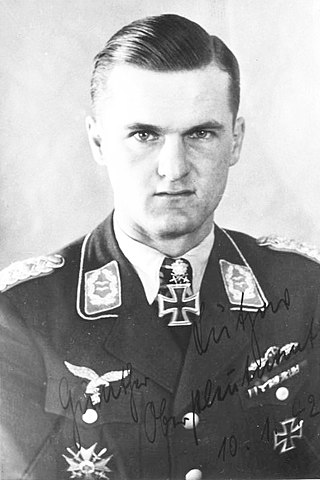
Günther Lützow was a German Luftwaffe aviator and fighter ace credited with 110 enemy aircraft shot down in over 300 combat missions. Apart from five victories during the Spanish Civil War, most of his claimed victories were over the Eastern Front in World War II. He also claimed 20 victories over the Western Front, including two victories—one of which was a four-engined bomber—flying the Messerschmitt Me 262 jet fighter.

Herbert Ihlefeld was a German Luftwaffe military aviator during the Spanish Civil War and World War II, a fighter ace listed with 130 enemy aircraft shot down in over 1,000 combat missions. Depending on source, he claimed seven to nine aerial victories in the Spanish Civil War, and during World War II, 67 on the Eastern Front and 56 on the Western Front, including 15 four-engined bombers and 26 Supermarine Spitfires. He survived being shot down eight times during his 1,000 combat missions.

Fritz Losigkeit was a German Luftwaffe military aviator during the Spanish Civil War and wing commander during World War II. As a fighter ace, he is credited with 68 aerial victories in approximately 750 combat missions. This figure includes 13 aerial victories over the Western Allies, the remaining victories were claimed over the Eastern Front.

Reinhard Seiler was a Nazi German Luftwaffe Major and ace of the Spanish Civil War and World War II, commander of Jagdgeschwader 104 and a winner of the Knight's Cross of the Iron Cross with Oak Leaves; for the fighter pilots, it was a quantifiable measure of skill and combat success. Reinhard Seiler was credited with 100 victories during World War II, over the course of about 500 combat missions. He recorded an additional 9 victories during the Spanish Civil War.
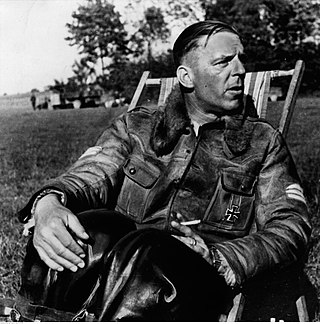
Walter Grabmann was a German general in the Luftwaffe during World War II. He was also a recipient of the Knight's Cross of the Iron Cross of Nazi Germany. Grabmann was credited with 7 aerial victories during the Spanish Civil War claimed in 137 combat missions.

Rolf Kaldrack was a Luftwaffe fighter ace and recipient of the Knight's Cross of the Iron Cross with Oak Leaves during World War II. A flying ace or fighter ace is a military aviator credited with shooting down five or more enemy aircraft during aerial combat. Kaldrack is credited with at least 24 aerial victories, 3 of which claimed during the Spanish Civil War flying with Aufklärungsgruppe 88 of the Condor Legion.
Joachim "Gnom" Wandel was a German Luftwaffe military aviator in the Spanish Civil War and a fighter ace during World War II. He is credited with 75 victories, two over the Western Front and 73 over the Eastern Front.
Horst Tietzen was a German Luftwaffe fighter pilot and recipient of the Knight's Cross of the Iron Cross during World War II.
Hans-Karl Mayer was a German Luftwaffe military aviator and fighter ace during Spanish Civil War and World War II. He is credited with eight aerial victories during the Spanish Civil War and further 31 aerial victories on the Western Front of World War II.
Rolf Pingel was a German Luftwaffe military aviator and fighter ace during the Spanish Civil War and World War II. He is credited with six aerial victories during the Spanish Civil War and further 22 aerial victories on the Western Front of World War II. He flew about 550 combat missions, including approximately 200 in Spain.

Rudolf Resch was a German Luftwaffe military aviator during the Spanish Civil War and World War II, a fighter ace listed with 94 enemy aircraft shot down. A flying ace or fighter ace is a military aviator credited with shooting down five or more enemy aircraft during aerial combat. He was credited with one aerial during the Spanish Civil War and further 93 on the Eastern Front of World War II.
Helmut Mertens was a German fighter ace of World War II. He was born in Essen and served in the Luftwaffe as a career fighter pilot who served in the Battle of France, Battle of Britain, the invasion of Russia Operation Barbarossa and on the Western Front in the Defence of the Reich. His victory tally as a fighter pilot is reported as high as ninety-seven or as few as fifty-four aircraft confirmed shot down.
Jagdgeschwader 234 was a fighter wing of Nazi Germany's Luftwaffe in World War II. It operated during peacetime and conducted formation flying, simulated aerial combat, and firing on ground targets. Many of its pilots came from Jagdgruppe 88 operating in Spain during the Spanish Civil War.

















